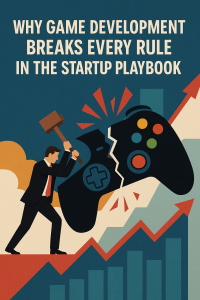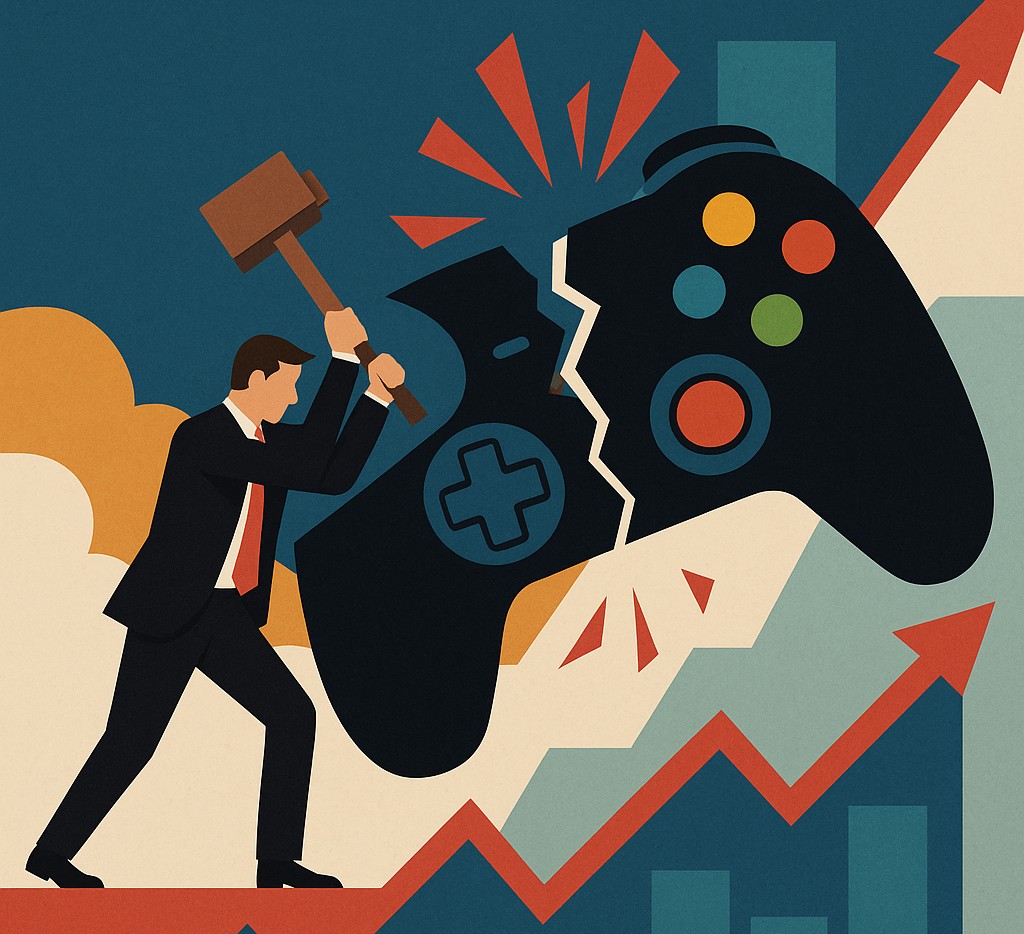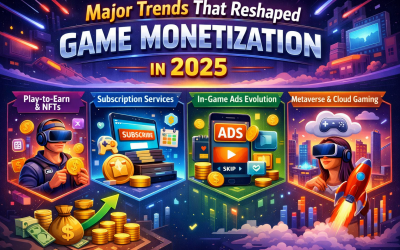Why Game Development Breaks Every Rule in the Startup Playbook
The startup world loves its frameworks. Lean methodology, MVP development, customer feedback loops, iterative design—these principles have guided countless companies from idea to IPO. But there’s one industry where these tried-and-true methods don’t just fail; they’re completely irrelevant. Welcome to game development, where the rules of business logic go to die.
Contents
The Problem with Traditional Startup Wisdom
 Most successful startups follow a predictable pattern. Identify a pain point, build a solution, test it with users, gather feedback, iterate, and scale. The process is methodical, measurable, and most importantly, logical. Users can articulate their needs, competitors provide benchmarks, and market research offers direction.
Most successful startups follow a predictable pattern. Identify a pain point, build a solution, test it with users, gather feedback, iterate, and scale. The process is methodical, measurable, and most importantly, logical. Users can articulate their needs, competitors provide benchmarks, and market research offers direction.
Consider a typical B2B software company. Customers will explicitly tell you what features they need, what price points work, and how your product fits into their workflow. The feedback is direct and actionable. If your project management tool is missing time tracking, users will request it. Add the feature, and satisfaction scores improve. Revenue follows.
This linear relationship between problem identification and solution delivery forms the backbone of modern entrepreneurship. It’s why accelerators teach customer discovery, why investors ask about market validation, and why “fail fast, learn fast” has become a mantra.
Where Games Break the Model
Gaming shatters this entire framework. Games don’t solve problems—they create experiences. Players can’t tell you what will be fun before they experience it, and often can’t explain why something is engaging after they’ve played it for hundreds of hours.
Imagine spending 24 months developing what appears to be the perfect game. The graphics are stunning, the mechanics are polished, the code is bug-free, and early focus groups provide positive feedback. Launch day arrives, and the game disappears into digital obscurity. No viral growth, no word-of-mouth, no sustained engagement. The investment—often millions of dollars—evaporates.
This scenario plays out constantly across the industry. Studios with decades of experience, unlimited budgets, and all the market research money can buy still produce games that fail spectacularly. The reason is simple: fun isn’t a feature you can engineer through traditional product development methods.
The Numbers Don’t Lie
The gaming industry’s success distribution follows a power law so extreme it defies conventional business logic. Research consistently shows that 95% of games generate less than $1,000 in lifetime revenue. Meanwhile, the top 1% of titles capture more than 80% of total market value.
This isn’t a healthy market distribution—it’s closer to a lottery system. Even experienced studios with proven track records struggle with these odds. Industry veterans commonly report canceling 10-15 projects for every title they release to market. These aren’t prototype failures or concept tests; these are fully developed games that simply couldn’t find their audience.
The harsh reality is that determining a game’s commercial potential often requires completing the entire development cycle. Unlike other products where market testing can happen early and cheaply, games need to be substantially complete before their true appeal becomes apparent.
Why Pivoting Doesn’t Work
Traditional startups can pivot when initial concepts don’t resonate. Slack famously started as a gaming company before becoming a communication platform. Twitter emerged from a podcasting company. Instagram began as a location-based check-in app.
Games don’t allow such flexibility. If your puzzle game isn’t engaging, you can’t pivot it into a racing game. If your RPG mechanics feel tedious, adding social features won’t transform the core experience. The fundamental gameplay loop either works or it doesn’t—there’s rarely middle ground.
When a game fails, most assets become worthless. Art created for a medieval fantasy setting can’t be repurposed for a sci-fi shooter. Code written for turn-based combat won’t help with real-time action. Unlike other failed startups that might salvage technology, customer relationships, or market insights, failed games typically offer nothing transferable.
The Investment Shift
Smart money has noticed these patterns. Venture capital increasingly flows toward gaming infrastructure rather than game development itself. Companies building tools, platforms, and services for the gaming industry offer more predictable returns than betting on individual titles.
Take monetization technology as an example. AppLixir specializes in rewarded video advertising—a system where players voluntarily watch ads in exchange for in-game benefits. Instead of gambling on whether a specific game will succeed, they’ve built infrastructure that helps successful games generate more revenue. It’s a classic picks-and-shovels strategy: rather than mining for gold, sell equipment to miners.
These infrastructure plays offer everything investors love: recurring revenue models, measurable growth metrics, and the ability to benefit from the overall industry’s success without depending on any single hit. They’re building the roads that successful games travel on, rather than trying to be the destinations themselves.
The Upside That Keeps Everyone Playing
Despite these sobering realities, game development continues attracting entrepreneurs, creators, and investors. The reason is simple: when games work, they generate wealth at scales that few other industries can match.
Top mobile games routinely generate $5-10 million daily. Fortnite made $9.1 billion in its first two years. Minecraft has sold over 300 million copies and continues growing. These aren’t just successful products—they’re cultural phenomena that create entirely new markets.
The mobile gaming revolution has also introduced sophisticated monetization strategies that didn’t exist in previous generations. Free-to-play models, in-app purchases, and rewarded advertising have created sustainable revenue streams that can support games for years or even decades after launch.
Modern successful games don’t just sell once—they build communities, create ongoing relationships with players, and generate revenue through engagement rather than just initial purchases. This shift has made the hits even more valuable, even as the misses become more costly.
The Human Element
What separates gaming successes from failures often comes down to intangible human factors. Timing, cultural resonance, social dynamics, psychological reward systems—elements that resist systematic analysis or prediction.
A game might succeed because it launches during a pandemic when people need escapism. Another might fail because a similar concept released three months earlier. Sometimes success hinges on a single influencer’s livestream, a viral moment on social media, or pure luck in algorithmic recommendations.
These human elements can’t be A/B tested, focus grouped, or market researched into existence. They emerge from the complex interaction between creator intent, player psychology, and cultural moment. It’s less like traditional product development and more like trying to predict which songs will become hits.
The Beautiful Contradiction
This uncertainty is precisely what makes game development both maddening and magnetic. It’s an industry where artistic vision, technical skill, and business acumen must align with cultural timing and pure chance. Success requires not just building something good, but building something that resonates with millions of people in ways that even the creators might not fully understand.
For every studio that closes after burning through investment, there’s another that creates the next global phenomenon. The potential rewards are so extraordinary that they justify the enormous risks, at least for those brave or foolish enough to play the game.
Game development will never follow traditional startup playbooks because it’s fundamentally different from other forms of entrepreneurship. It’s not about solving problems or meeting needs—it’s about creating joy, wonder, and experiences that didn’t exist before. And perhaps that’s exactly why, despite all the failed projects and lost investments, people keep trying to build the next great game.
In an industry where failure is the norm and success defies explanation, the only certainty is that the next breakthrough could come from anywhere. And for dreamers and risk-takers, that possibility makes all the difference.



